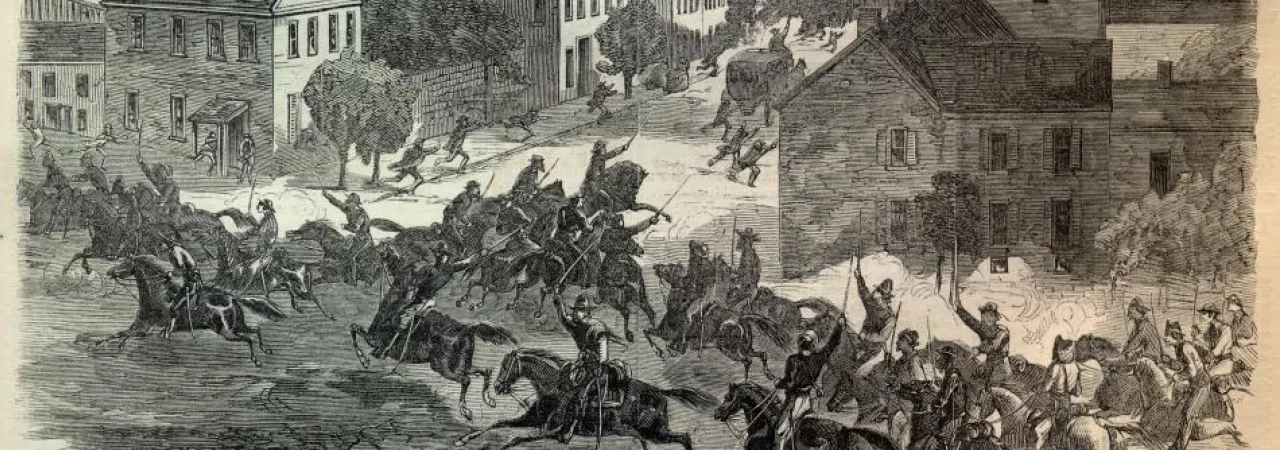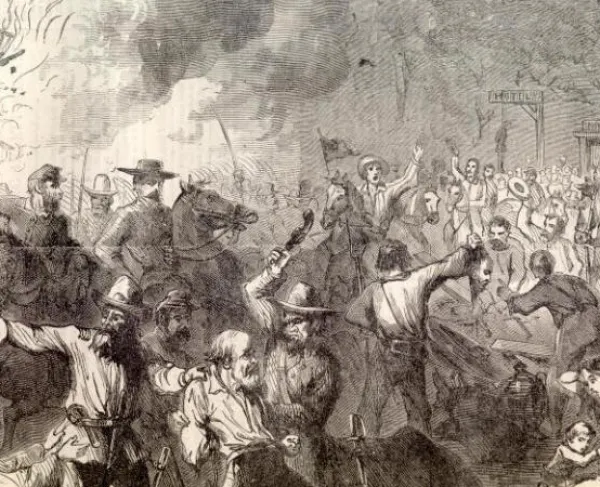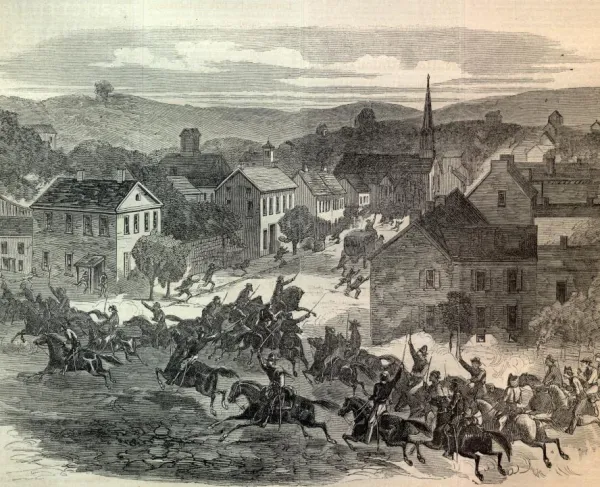
While frequently spectacular, guerrilla warfare had limited strategic impact.
After traveling 1,100 miles in two weeks, John Hunt Morgan and his men had reached the end of their raid through Kentucky and states north of the Ohio River. Beginning July 2, 1863, Morgan tore through Kentucky and Indiana, destroying Union railroads and pillaging communities along the way. Union forces, commanded by Brigadier Generals James M. Shackelford and Edward H. Hobson, in cooperation with the Navy “tin boats” under Lt. Cdr. Leroy Fitch was ordered to capture Morgan. On July 13, 1863, the confederate raiders reached Ohio soil, panicking Ohio inhabitants. Morgan and his men would spend most of their time in the state eluding militiamen as their Confederate cavalry raced toward the West Virginia border. The afternoon of July 13, the raiders embarked on their longest continuous march through the night, moving at a steady, but exhausting pace. Their aim was to reach a narrow, unguarded corridor between Cincinnati and Hamilton. They distracted the Federals by feigning toward both cities, leaving a clear path for Confederate men to pass through.
Morgan’s next destination was a ford along the Ohio River, another 100 miles to the east. Buffington Island had been selected that previous spring by Confederate Captain Sam Tyler on an earlier reconnaissance through Ohio. The sandy bar of Buffington Island was the closest and most ideal location for crossing the Ohio River. With West Virginia in mind, Morgan pushed his men onward with the Federals still hot on their heels. By mid-July, one out of every five of the men who had begun the raid at the beginning of the month – 3,000 strong – was no longer reporting for duty. Raiding towns along the way, the Confederates tried to keep up their momentum through July 16th and 17th. Home guard units tried to slow Morgan’s progress by creating obstacles of fallen trees in the roads and tearing down bridges. These delays afforded the Union Michigan and Kentucky cavalry time to catch up to Morgan’s constantly moving column.
On July 18th, Morgan split his brigades into two columns upon their approach to Pomeroy, Ohio. Union Brig. Gen. Henry M. Judah, commanding Indiana and Illinois cavalry from Louisville, brushed with Morgan’s flanks, engaging in a skirmish with Confederate officer Adam Johnson’s brigade before Morgan’s men hurried around the fortified town. Throughout the morning and afternoon of that day, Morgan’s raiders dodged militia units and regular Ohio troops as they continued eastward. They arrived in Chester, Ohio around one o’clock, where Morgan finally halted his men for two hours. They were still 18 miles from Buffington Island. This short rest would give their Federal pursuers more time to head off Morgan and block his path.
The Union Marietta Militia, aware of Morgan’s movements, accurately predicted his intended target and moved quickly to construct earthworks and position artillery around the ford at Buffington Island. Commander Fitch had deployed five of his “tin clads” along a forty-mile stretch of river, guarding many shallow, fordable crossing points, with Fitch’s gunboat, the Moose, assigned to guard Buffington Island. The Ohio River was also running much higher than normal for the summer season, making the island nearly indiscernible from the shore. According to residents, the river had not been that high in the 20 years prior to the battle.
Morgan arrived at Portland along the Ohio River the night of the 18th and set up headquarters at the Tunis Middleswart farmhouse, central to Portland Bottoms and northwest of Old Portland. He sent scouts toward the ford to inspect the area. Confederate Major James McCreary noted, “All were now on the qui vive, for the Ohio River is full of gunboats and transports, and an immense force of cavalry is hovering in our rear.” The dense fog and darkness that enveloped the scene screened much of the scouts’ view, but they could ascertain that three hundred Union infantry, at least two artillery pieces, and a strong set of earthworks blocked their path. For the 1,800 Confederates present, this did not appear to be much of a concern. He sent forward Warren Grisby’s 6th Kentucky, D. Howard Smith’s 5th Kentucky, and Capt. Edward Brynes’ battery to within 400 yards of the earthworks. Confederate parrot rifles under the direction of Lt. Elias D. Lawrence were also positioned on a high bluff overlooking the crossing. In the meantime, scouts were dispersed to find another, less defended crossing. Morgan planned to wait until the first light of dawn before storming the earthworks. The Confederates attempted to sleep with the knowledge that the morning would bring a battle, despite most of them possessing no more than two or three rounds of ammunition to defend themselves.
On the morning of July 19 at about 5:30, Morgan’s plan was executed. However, the assaulting troops found the works empty and the two field pieces rolled over a nearby bluff. To their eyes, the works had been abandoned. However, hidden by the cover of the dense morning fog, was Judah’s force of 1,000 men, a brigade of cavalry, and several artillery batteries that had arrived at the ford after a night march from Pomeroy. Morgan had placed pickets on the Bald Knob-Stiversville Road but had failed to guard the road leading to Pomeroy. General Judah’s advancing troops were scattered by Confederate artillery fire, but quickly reformed. In the assault, Major Daniel McCook was shot down and 30 Federals were captured.
D. Howard Smith and his 5th Kentucky retreated a short distance to the north before Judah’s troops, consisting of the 7th and 8th Michigan and 5th Indiana, caught up and unleashed a counterattack. This pushed the Confederates further north and right into Union Brig. Gen. Edward H. Hobson’s advance that had arrived from Chester, consisting of the 8th and 9th Michigan Cavalry, 11th Michigan Battery, 2nd and 7th Ohio Cavalry, and 5th Kentucky Cavalry under Col. William Sanders. The 5th Indiana under Lt. John O’Neal stormed Lawrence’s defensive position and captured the Confederate guns, turning them on the Rebels. The Confederates retreated out of the woods and further east, toward the river, where the Union flag boat, the Moose, was waiting to open fire with its twenty-four pounder Dahlgren gun. Captain John Grafton, a former staff officer under General Judah, had been separated from his unit and picked up by the Moose, from where he pointed out the Confederate positions to the captain, ensuring that their artillery fire was deadly accurate.
The raiders were caught in a three-way crossfire, with Judah’s men to the south supported by the captured artillery under O' Neal, Hobson’s troops to the west, and the gunboats on the river. The Confederate position resembled a giant “L” shape with Basil Duke’s line facing south and Johnson’s line facing west. “The scream of the shells,” Duke wrote later, “drowned the hum of the bullets… and bursting between the two lines formed at right angles… the air seemed filled with metal, and the ground was torn and ploughed into furrows.”
The Confederates endured the barrage for half an hour but could not hold the position with their depleted ammunition and Captain Brynes’ battery having been rendered ineffective from their clogged bores. Some men from Grisby’s and Smith’s regiments managed to escape to the muddy shore of the river after tossing away their arms and accouterments, but only 140 would make it to the other side. Further upstream, elements of the 9th Tennessee launched a repaired flatboat and escaped undetected by the Moose or the Allegheny Belle that soon joined her in the bombardment, captained by Nathaniel Pepper.
Morgan ordered a retreat north, the only direction available to them. He took with him the 2nd, 8th, and 11th Kentucky and the 9th Tennessee. Duke and Johnson covered the retreat north through a narrow pass that led out of the valley, Lauck’s Run Road. The effort began orderly, but soon devolved into a tangled mass of supply wagons and infantry. To unburden the wagons, the fleeing raiders discarded the booty they had acquired during the raid. A reporter for the Cincinnati Gazette would later report, “On the battlefield of Buffington Island, one could pick up almost any article in the dry goods, hardware, house furnishings, or ladies’ and gentlemen’s furnishings.”
Chaos reigned that morning as Confederates broke and rallied numerous times, ran out of ammunition, became entangled with other regiments, and separated from their commanding officers. Federal Brig. Gen. Eliakim P. Scammon’s infantry disembarked from a gunboat further south, on standby as reserves to the Federal force that progressed northward. Michiganders overtook the bluff to the west, therefore controlling the flanks of both Duke and Smith’s perpendicular lines as the Federals closed in.
Officers failed to keep their columns in order, all the while shells bursting in their midst. Duke wrote, “The upper end of the valley was filled with wagons and ambulances, whose wounded and terror-stricken occupants urged the scared horses to headlong flight. Often, they became locked together and were hurled over as if by an earthquake. Occasionally, a solid shot or unexploded shell would strike one, and dash it into splinters… The remaining section of artillery was tumbled into a ravine, during this mad swirl, as if the guns have been as light as feathers. The gunboats raked the road with grape… In a moment the panic was complete, and the disaster irretrievable.”
Johnson and Duke began a slow withdraw to the north to follow Morgan, abandoning artillery and supplies in the wake of the chaos. The latter, however, would surrender to the Federals along Lauck Run just after 7:30 am. A ceasefire was ordered, and Captain Theodore Allen was sent forward to accept Duke’s surrender. Allen would later recall that Duke “bore himself with great dignity, and I would not have known I had him if one of his own men had not accidentally disclosed his identity to me.” Some 700 Confederates were taken prisoner, with an additional 325 captured in the vicinity of Basham Church to the north and further south between Portland and Pomeroy. The battle of Buffington Island lasted three and a half hours, resulting in 57 Confederate dead and between 150 and 200 wounded. Of the approximately 3,000 Federals that participated in the battle, only 55 casualties were incurred.
The James Williamson and J. Richey houses were commandeered as a field hospital for the wounded Federals and Confederates after the battle. The prisoners of war were marched 10 miles to two waiting transports that would shuttle them to Cincinnati. The long march in the intense summer heat took a toll on the weary Confederates, with many fainting from exhaustion or becoming lame along the journey. The 68 captured Rebel officers would remain at the Ohio Penitentiary while the enlisted men were taken on a special train to Camp Morton at Indianapolis. Others would end up at Camp Douglass in Chicago, Camp Chase in Columbus, or Johnson’s Island at Sandusky. The spectacle of “Morgan’s terrible men” attracted many onlookers in Cincinnati.
Morgan escaped capture with approximately 1,100 of his raiders and raced northward to find another fordable river crossing. General Shackelford, Hobson’s rearguard, was ordered to intercept the retreating raiders. After further run-ins with the Federals throughout the following week, Morgan’s force that fled with him after the battle at Buffington Island was eventually depleted to less than 400. He had yet to cross into West Virginia, despite further efforts, and he had become increasingly vulnerable since the morning of July 19.
The battle at Buffington Island had not only reduced his force, but also his ammunition and supplies. Morgan knew that their horses – acquisitions from farms across Indiana - could not outrun the enemy on his tail. It would only be a matter of time before he would be overtaken. A week after the battle at Buffington Island, on Sunday, July 26, Morgan and the last of his raiders, numbering 364 men and almost 400 horses, surrendered at West Point, Ohio, at two o’clock in the afternoon. Morgan often said, “Everything important happens to me on Sundays,” and his observation was correct on two occasions that July. After his surrender, Morgan was taken to Cincinnati, joining those captured at Buffington Island, and drawing a crowd of 5,000 who came to catch a glimpse of the infamous Confederate raider.
Related Battles
55
1,175






